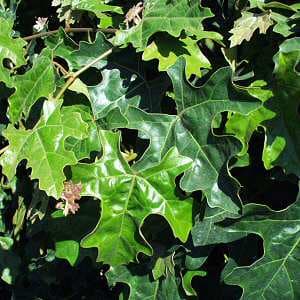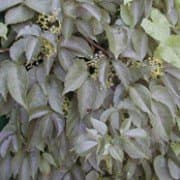Porcelainberry Ampelopsis brevipedunculata 'Elegans' (v)

ABOUT
Ampelopsis brevipedunculata 'Elegans', also known as variegated porcelain berry, is a climbing vine that is prized for its ornamental features. The plant exhibits a stunning display of foliage and berries that add a unique aesthetic to any garden space. The leaves are heart-shaped, and each one is a canvas of artistic splashes, with creamy white and pink on a green background, giving the vine a variegated appearance. During the growing season, the plant produces inconspicuous small greenish flowers that eventually transform into clusters of berries. As the season progresses, these berries go through a breathtaking metamorphosis, beginning as a soft porcelain blue and graduating through a spectrum that includes purples, pinks, and even rich amethyst tones. The berries are small and round, reminiscent of miniature grapes, and they stand out against the foliage for their jewel-like quality. Overall, the variegated porcelain berry is celebrated for its striking variegated leaves and the vivid, almost iridescent, display of colorful berries that create an appealing visual contrast. This aspect, combined with its growth habit, makes it a popular choice for gardeners looking to add vertical interest and a splash of color without considering the plant's specific dimensions.
About this plant
 Names
NamesFamily
Vitaceae.
Synonyms
Variegated Porcelain Berry, Variegated Porcelain Vine, Elegans Porcelain Berry.
Common names
Ampelopsis glandulosa var. heterophylla, Ampelopsis heterophylla.
 Toxicity
ToxicityTo humans
The plant commonly known as porcelain berry is considered to have a level of toxicity to humans. If ingested, the berries of the porcelain berry plant can cause gastrointestinal issues such as vomiting and diarrhea. It is important to avoid eating any parts of the plant due to the risk of these unpleasant symptoms.
To pets
Porcelain berry is also toxic to pets. If a pet ingests parts of this plant, particularly the berries, they may experience similar symptoms of toxicity as humans do. These can include vomiting, diarrhea, and abdominal pain. Ingesting the plant can be harmful to pets, so it's crucial to prevent them from consuming any parts of the porcelain berry.
 Characteristics
CharacteristicsLife cycle
Perennials
Foliage type
Deciduous
Color of leaves
Variegated
Height
15 feet (4.57 meters)
Spread
10 feet (3.05 meters)
Plant type
Climber
Hardiness zones
4
Native area
Asia
Benefits
 General Benefits
General Benefits- Aesthetic Appeal: The 'Elegans' variety of Porcelain Berry is known for its decorative features, including its variegated leaves and attractive berries that change color from green to pink, lavender, and finally to a porcelain blue.
- Habitat for Wildlife: The berries it produces serve as a food source for various species of birds and can help support local wildlife populations.
- Shade Tolerance: This plant has the ability to grow in areas with partial shade, making it suitable for planting under trees or in spots with variable light conditions.
- Fast-Growing: As a fast-growing vine, it can quickly cover trellises, arbors, and fences, providing a green screen or shade where needed.
- Erosion Control: When used as ground cover, the dense foliage and robust growth habit of Porcelain Berry can help stabilize soil and prevent erosion.
 Medical Properties
Medical PropertiesThis plant is not used for medical purposes.
 Air-purifying Qualities
Air-purifying QualitiesThis plant is not specifically known for air purifying qualities.
 Other Uses
Other Uses- Variegated porcelain berry can be used for dyeing fabric. The berries produce a light green or yellow dye depending on the mordant used.
- The plant's flexible stems can be woven into baskets and other craft items, taking advantage of its natural durability and pliability.
- Variegated porcelain berry's abundant fruit clusters can be used in floral arrangements, where their colorful appearance adds an exotic aesthetic.
- The vines can be grown over pergolas or garden structures to create shaded areas, as they provide dense foliage and rapid coverage.
- Its colorful berries can be used in the production of homemade inks for art projects.
- The plant can serve as a living fence or natural barrier when planted in a row or along the edge of a property.
- Due to its rapid growth and dense cover, it can be utilized for erosion control on slopes or areas prone to soil degradation.
- Variegated porcelain berry can be used as a natural backdrop to enhance the aesthetic of staged outdoor photography or events.
- The vine can be trained onto trellises or topiary frames to create intricate garden sculptures or designs.
- In an educational setting, it can serve as a model organism for studying invasive plant behavior and management techniques.
Interesting Facts
 Feng Shui
Feng ShuiThe plant Porcelain Berry is not used in Feng Shui practice.
 Zodiac Sign Compitability
Zodiac Sign CompitabilityThe plant Porcelain Berry is not used in astrology practice.
 Plant Symbolism
Plant Symbolism- Adaptability: The Ampelopsis brevipedunculata, commonly known as porcelain berry or variegated porcelain berry, is a fast-growing vine known for its ability to adapt to various environments, signifying versatility and flexibility in life.
- Transformation: As the vine changes color throughout the seasons, from green in its youth to a mix of lilac, green, and cream as it ages, and eventually to deep blue and purple berries, it symbolizes transformation and growth.
- Beauty in Variety: The porcelain berry's colorful berries and variegated foliage highlight the beauty of diversity and the aesthetic value of different traits coming together harmoniously.
- Persistence: Given its vigorous growth habit, the porcelain berry exemplifies persistence and the idea of persisting through various conditions to thrive.
- Invasive Nature: This plant can also symbolize domination or loss of balance, as porcelain berry is considered invasive in some areas, where it may overtake native species and disrupt local ecosystems.
 Water
WaterThe Porcelain Berry requires watering when the top inch of soil begins to feel dry, usually once every week, though the frequency may vary based on the climate and weather conditions. Ensure the plant receives deep watering to promote a healthy root system; this might be approximately 1 to 1.5 gallons, depending on the plant's size and the environmental conditions. During the summer, you may need to water more frequently, while in winter, the plant requires less water. Overwatering can cause root rot, so it's important to let the soil dry between waterings.
 Light
LightThe Porcelain Berry thrives in full sun to partial shade conditions. It is best placed in a spot where it can receive at least 4 hours of direct sunlight each day, which encourages healthy growth and fruit production. However, in regions with extremely hot summers, a location with afternoon shade will help prevent leaf scorch.
 Temperature
TemperatureThe Porcelain Berry plant prefers temperate conditions and can tolerate a temperature range from around 20°F to 85°F. The ideal temperature range for vigorous growth is between 60°F and 80°F. It is fairly adaptable to different temperature zones, but it should be protected from severe frosts.
 Pruning
PruningPorcelain Berry plants require regular pruning to control their vigorous growth and to maintain their shape. Prune in late winter or early spring before new growth begins. Cutting back the vines by a third each year will encourage fresh growth and prevent the plant from becoming too dense. The best time for extensive pruning is when the plant is dormant, to minimize stress and sap loss.
 Cleaning
CleaningAs needed
 Soil
SoilPorcelain Berry ('Elegans' variety) thrives in a well-draining soil mix composed of loam, compost, and a small portion of sand to increase porosity. Aim for a soil pH around 5.5 to 6.5, which is slightly acidic to neutral.
 Repotting
RepottingPorcelain Berry should be repotted every 2-3 years during spring to accommodate its growth, ensuring fresh soil and room for root development.
 Humidity & Misting
Humidity & MistingPorcelain Berry prefers moderate humidity levels, ideally between 40-60%, to mimic its natural growing conditions.
 Suitable locations
Suitable locationsIndoor
Provide bright light, moderate humidity, and well-draining soil.
Outdoor
Plant in partial shade, well-draining soil, protect from harsh weather.
Hardiness zone
4-8 USDA
 Life cycle
Life cycleThe life cycle of Ampelopsis brevipedunculata 'Elegans', commonly known as Variegated Porcelain Berry, begins with seed germination in spring when temperature and soil conditions are favorable. The seedling emerges and develops into a juvenile plant with distinctive, variegated leaves. As it matures, it grows into a vigorous, deciduous, woody vine that can climb by means of tendrils. Throughout the summer, the vine produces small, inconspicuous flowers which are followed by the striking porcelain-like berries that change color from green to lilac to blue as they mature. In autumn, the plant loses its leaves and goes into dormancy during the winter months. It resumes growth the following spring, completing the perennial cycle.
 Propogation
PropogationPropogation time
Spring to Summer
The Variegated Porcelain Berry, Ampelopsis brevipedunculata 'Elegans', can be propagated most effectively through softwood cuttings taken in late spring or early summer. For this method, select a healthy, non-flowering stem and make a cutting about 4-6 inches (10-15 cm) long, with several sets of leaves. The lower leaves should be removed, and the cut end dipped into rooting hormone to encourage root development. The prepared cutting should then be planted in a well-draining soil mix, ensuring that at least one set of leaves is above the soil surface. The pot with the cutting needs to be kept in a warm, humid environment with indirect light; covering the pot with a plastic bag can help maintain humidity. After a few weeks, the cutting should develop roots and can eventually be transplanted outdoors after the risk of frost has passed.







![Grape [Claret Cloak]](/_next/image?url=https%3A%2F%2Fplants-admin.emdemapps.com%2Fimages%2Fplants%2F%2Fimages%2F604b602abe2f8.png&w=640&q=75)

